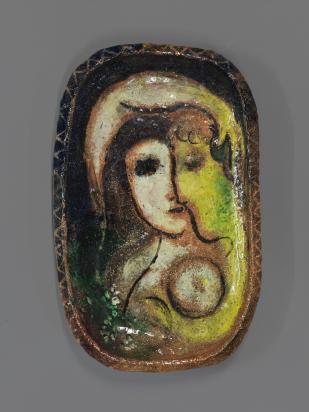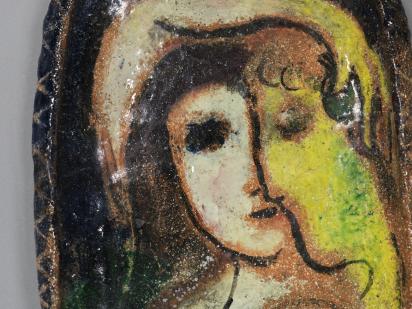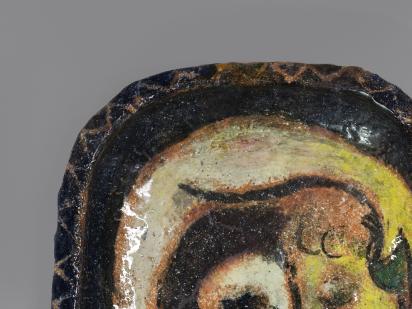Chagall made Two Faces, an elongated ceramic with rounded edges, in 1951. Unlike the dishes he produced earlier, for example the 1950 series illustrating La Fontaine's Fables, this more hollow piece gave the artist a chance to explore three-dimensionality.
The contour lines and stylized forms recall his works on paper from the same period, such as Beauty with Flowers [La Belle aux fleurs] (1950). The intense black background, which Chagall already experimented with in Lovers With Goat [Amoureux avec chèvre] (1950), contrasts with the two figures, who are depicted in lighter tones. Chagall used chiaroscuro in the same way for the ceramic Mother and Child [Mère et enfant] (1951), making these pieces akin to easel paintings. The contrast is also visible in the materials, to which he paid close attention.1 The roughness and relief of the chamotte clay underneath the smooth, shiny glaze give the work depth, while the decorative edging lends it an archaic look.
The two beings seem to form a single entity recalling the shape of the piece itself, like a pair of bodies merging with each other or a double face, a recurring image in Chagall's work that can be seen, for example, in The Black Glove (1923-1948). The luminous hues—white, yellow and green—also illustrate what Franz Meyer calls “astral symbolism”2 or “moon-sun symbolism”.3 The two-faced portrait might evoke the duality of the soul depicted in Sh. An-ski's play The Dybbuk, in which “the dybbuk” (the soul of the deceased Hanan) takes “possession of his betrothed's body on her wedding day”.4 The Habima troupe wanted Chagall to design the sets, but in the end it was artist Nathan Altman who did.5 An-ski’s play is later mentioned several times in the artist's correspondence, notably in a 1947 letter to his daughter Ida, in which he expressed great interest in a ballet project based on The Dybbuk.6





